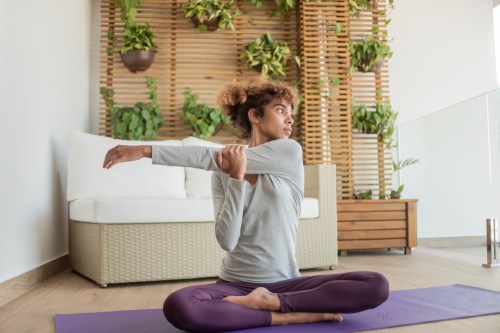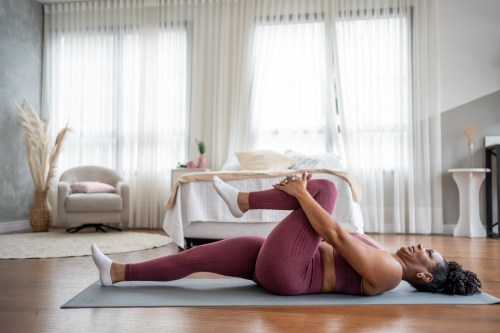‘Fascia Flossing’ Is the Little-Known Secret for Improving Your Mobility—Here’s How To Do It
Fascia flossing is a mobility technique used to lengthen and strengthen tissue to increase circulation and improve movement. Learn more here.

If you don’t floss your teeth every night, your dental hygienist will probably warn you about gingivitis during an extra long teeth-cleaning session.
Experts in This Article
Dancer, yoga teacher, body worker and cofounder of workout apparel brand Ghost Flower Active.
But as it turns out, your pearly whites aren’t the only thing in your body that can benefit from the practice. Your fascia (aka connective tissue) needs a little flossing from time to time, too. Intrigued?
Keep reading to learn everything there is to know about fascia flossing.
First things first: What is fascia?
“Fascia is the body’s scaffolding, a matrix of hydrated, semi-crystalline collagen fibers in varying strengths and interweaving patterns that wraps around our organs, bones, tendons, ligaments, brain matter, and more,” says Bonnie Crotzer, founder of the fascia-focused movement method The Floss.
If not for fascia, our bodies would essentially collapse. “Without the tension and compression of the connective tissue network, we would have no form,” explains Crotzer. “Fascia takes on the [shape] of whatever it is wrapping while maintaining separation—for example between organs—and creating continuous connectivity throughout the body.” TL;DR: It’s really important—and not just physically speaking.
A growing body of research indicates that our fascia acts as an archive of our most emotional and distressing experiences. Most notably, trauma. “Recent research has shown that all past traumas, both physical and mental, are stored within the fascia1, causing its natural form to be disrupted and hardened to hold the body in a distressed state,” Crotzer says.
Taking it a step further, research indicates that—left alone—fascia can harden and impair movement and circulation. “So when we feel a knot in any muscle, it’s a build-up of fluid, toxins, adhesions, and scar tissue within the fascia that’s unable to move within the lymphatic system of the body,”Crotzer says.
Fortunately, there are a number of ways to care for your fascia while improving your mobility and flexibility in the process. Ahead, Crotzer gives you the 411 on fascia flossing, its benefits, and five easy moves you can try today. (No more muscle gingivitis for you, fam.)
So, what is fascia flossing?
“Fascia flossing, a term that I coined in 2019, describes the simultaneous elongation and contraction of major muscle groups dictated by Traditional Chinese Medicine (TCM) meridians,” Crotzer says.
In TCM, meridians are 12 energy (or “Qi”) passageways through the body2 that are often used in acupuncture. For example, the heart meridian runs from your armpit to the tip of your pinky finger. (Try extending one arm straight out to your side, and holding your hand out like a stop sign. Gently tilt your neck the opposite way, and you’ll probably feel your heart meridian stretching and activating.)
In fascia flossing, elongating and contracting the fascia along these meridians creates what Crotzer calls “internal exfoliation,” which breaks up old connective tissue, and releases toxins stored in the fascia. It’s also commonly known as an eccentric contraction and/or pandiculation, she adds.
“To say it more simply, we pandiculate when we yawn and an involuntary contraction happens as you extend your arms wide,” she shares. “There is tension or resistance in the movement. You have seen animals do it when they pull their paws back into a downward dog, they don’t go into a position, and hold and breathe—they are engaging their tissues as they coax their bodies into a more ‘awake’ state.”
All of this sounds really complicated (and hey, it is), but in practice, you can think of fascia flossing as intentional stretch and mobility work. (Here’s what happens if you don’t stretch. Spoiler: It’s not exactly good news.)
And if you’re someone who’s ever used a foam roller or massage ball, you’ve already experienced some of this in the form of self-myofascial release (SMR)3, which focuses on releasing tight spots in fascia through massage and manipulation of the connective tissue. The difference is that fascia flossing emphasizes mobilizing fascia along your meridian channels specifically to keep blood (as well as good vibes) flowing.
This 15-minute foam-foam roller self-massage video is a great example of SMR in action:
The benefits of fascia flossing
We’ve talked a bunch about the benefits of fascia flossing, but just to put a finer point on it, let’s review. Although fascia flossing is a new concept (and thus, needs more concrete research), Crotzer explains that it offers a host of advantages for everybody. Like SMR, “fascia flossing alleviates scar tissue4, densified fascia, and systemic stagnation for an almost immediate sense of improved mobility, tension relief, and symmetrical posture,” she says.
She adds that some of her students have experienced improvement in their digestive and hormonal health since beginning their fascial flossing journey, which anecdotally makes sense seeing as de-stressing can have positive impacts on your gut and cortisol levels.
But, of course, everyone will experience their own personal benefits. “As a practitioner who feels more open and spacious in their body, fascia flossing impacts the health of the nervous system, relieving daily stress and eventually helping to resolve past traumas,” Crotzer says. Similar to how certain yoga poses like hip openers can bring about emotional releases and even tears.
With all this in mind, you’re ready to start flossing your fascia.
Are there any risks?
“If you think you are fascia flossing, but instead you are doing something else— hyper-extending your knee, not contracting as you elongate—you could injure yourself,” Crotzer says. “The risk of self-injury exists with all movement practices, so learn from a teacher and practice properly. I have a lot of students come to me who have been injured through dance, like I was, or yoga, and once they learn the practice, they are able to recover, and go back to the movement practice they love.”
Overall, Crotzer says the greatest risk is not forego flossing. “The more pliable, functional, and elastic your tissue is, the more preventable an injury is, the less likely that repetitive motions will cause substitution or adhessive tissue,” she explains.
“Fascia flossing alleviates scar tissue, densified fascia, and systemic stagnation for an almost immediate sense of improved mobility, tension relief, and symmetrical posture.” —Bonnie Crotzer
What equipment do I need to start fascia flossing?
Zero, zilch, nada! You can explore fascia release techniques at home, with nothing more than your body and the ground. That’s the beauty of fascia flossing: It’s basically innate. When engaging in the mobility exercises, you’re just moving back and forth through the dynamic stretches and acknowledging where you feel it.
“We probably flossed as children when we pandiculated, but it was instinct, we are just picking up that instinct that animals still have, and using it as a science, a skill, to reclaim the potential of our human form,” Crotzer says.
Now, if comfort is of the utmost importance to you, just know that you may want to perform your fascia flossing on a carpet or yoga mat. “Yoga blocks or substitutes (two think books work!) are great too, or something to support yourself on for balance,” Crotzer shares.
5 fascia-flossing moves to get you started
1. TMJ
- 1.Start lying on your back with legs bent and feet flat on the floor.
- 2.Cross your ankle over left thigh, just above the knee (foot flexed).
- 3.Press left knee into right ankle for resistance, then drop both legs over to the right side and slowly pull them back to center.
- 4.Repeat 10 to 30 times and then switch to the other side.
The benefits: “This move is beneficial for TMJ as the fascial tissue of the jaw and quad live on the same meridian—the stomach meridian in TCM—with the quad having the densest amount of fascia along this particular chain,” Crotzer says. “As the fascia from the quad releases, it will allow the jaw to release as well.”
2. Upper-body floss
- 1.Start on all fours with knees under hips and forearms on the floor so elbows are right under shoulders. Forearms make a number 11, meaning they’re parallel and palms are pressing down.
- 2.Tuck your toes under, and slowly pulls your hips back to hover over your heels. Arms will straighten, and (without moving them) feel like your dragging your elbows back toward your knees.
- 3.Slowly pull yourself forward, lifting hips, moving through all fours, and pushing your shoulders forward of your elbows.
- 4.Repeat rocking back and forth 10 to 30 reps.
The benefits: “This move helps open up the fascia around the upper back, lats, armpits and upper arms and is great for moving stagnant lymph. Great for those who work at a desk and tend to hunch in their upper body,” Crotzer says.
3. Upper shoulder floss
- 1.Sit with your feet flat on the floor knees wide with elbows inside the knees, hands together, palms pressing into one another (you can watch Crotzer demo this in the second video above at 16:40).
- 2.Keeping hands together, spread elbows wide pressing out to open knees, then squeeze knees closed to bring elbows together, lengthening the spine to sit up taller as you do.
- 3.Repeat 5 to 10 times.
The benefits:“This floss is great for relieving tension around the neck and traps, and allows the shoulder to retract. It could also support digestion as it is activating the small intestine meridian in TCM,” Crotzer says.
4. Hamstring floss
- 1.Come into a kneeling lunge with right foot forward.
- 2.The left leg stays back with left knee on mat, toes untucked, and torso over the right quad.
- 3.Arms are straight by sides, hands under shoulders and either be on the floor (propped up on finger tips) or you can bring them onto two blocks or books to bring the ground closer (demo at time stamp: 3:28 in the video above).
- 4.Flex right toes up to the sky, digging heel into the mat, energetically pulling back in space (it won’t really move backward) as you sit your hips back over left heel and straighten front leg.
- 5.Come back to starting position bringing right foot down and lunging forward to feel stretch across the quad and hip of your left leg.
- 6.Repeat 10 to 30 times on each side.
The benefits: “This floss allows the pelvis to come back into neutral position and stack the spine with more space between each vertebra, which relieves the low back and supports an erect posture,” Crotzer says, adding that overtime this move may also release neck pain.
5. Pelvic floss
- 1.Lie on your back with a pillow under your head and press your left foot into a wall.
- 2.Cross your right ankle over your left thigh, just above the knee.
- 3.Create tension by pressing left thigh into right heel and right heel into left thigh.
- 4.Then use hands to hug right knee into chest, then use palms to press it gently away from you.
- 5.Repeat 10 to 30 times on each side.
The benefits: “Try this floss for low back support and to change the functionality in your glutes,” Crotzer says. You tend to hold a lot of tension in your hips, so don’t be surprised if this movement makes you more emotional, as well as mobile.
FAQ
1. Can fascia flossing help relieve muscle soreness?
It sure can. Since fascia exists all throughout the body, Crotzer says that fascia flossing can alleviate soreness from head to toe, including back pain.
“Sore quads or hamstrings after a run, or tech neck pains, can diminish or disappear after a session of fascia flossing,” she explains. “Students report things like this back to me all the time. As I like to say, fascia flossing is like getting a massage and workout in one.”
The reason fascia flossing can offer such relief is because the mobility exercise works to reduce inflammation and release nerve compression.
“That achy spot where the tissue feels tough, hardened, dry or even unconscious (like you can’t connect or activate that area)? Well, fascia flossing helps make that tissue elastic, springy, and hydrated again,” Crotzer says. “As the tissue itself is being revitalized, any toxins that the tissue has been storing, will be released, blood flow improves, and healing occurs.” This, in turn, benefits and soothes aching muscles. “Fascia is one of the storehouses in the body, so as it is [unbound], anything that is stored there can be freed as well, including old injuries,” Crotzer adds.
2. Is fascia flossing safe for everyone to try?
Generally, yes. “Fascia flossing is very accessible for most bodies from our super tight, tight friends to our hyper mobile buddies,” Crotzer says. “As long as it is practiced properly, it is as safe as walking, or yoga, or anything else.”
The exception here is if you have a debilitating injury or recently underwent surgery, in which case Crotzer recommends checking with your doctor before engaging in any fascia flossing movements.
3. How often should you practice fascia flossing for best results?
Considering fascia flossing is emulating a naturally occurring behavior (pandiculation), Crotzer says that it’s totally fine to work the mobility exercises into your regular routine.
“I would start out every other day and see how the progress and recovery goes,” she suggests. “It all depends on how much time you spend doing it. If you practice intensely one day, I might suggest rest for a day or two, depending on how quickly you recover, especially if you are just starting out.”
Speaking of intensity and duration, in general, Crotzer recommends engaging in fascia flossing five minutes in the morning and/or mid-day, starting at 50 percent resistance capacity to allow your body to adjust to the movements.
“Ideally, spend at least five to 10 minutes a day just to loosen up the body; students floss anywhere, in front of the TV, before bed, at the office, in a park,” she says. “The idea is to keep moving forward with the practice, so we maintain leverage on how life affects our fascia, and we keep slowly improving the health of our fascia, so we become more relaxed, limber, and move more gracefully and effortlessly.”
As fascia flossing becomes second nature to you, Crotzer says that you may find yourself craving a full practice, in which you could easily spend 30 to 60 minutes a day working through the fascial stretching.
4. Can fascia flossing improve athletic performance?
Because fascia flossing lengthens and strengthens tissue and tissue plays a vital role in mobility, yes.
“I’ve worked with a number of professional athletes, for example, who have seen their performance improve, simply because a muscle that contracts better, works better, faster… a muscle whose fibers can slide and glide more, it can contract more effectively,” Crotzer says. “One person I know who was not a professional athlete saw their running speed go from 15 mph to 20 mph over the course of a few years of doing this practice, mainly because their quads and hamstrings changed so much.”
Zullo A, Fleckenstein J, Schleip R, Hoppe K, Wearing S, Klingler W. Structural and Functional Changes in the Coupling of Fascial Tissue, Skeletal Muscle, and Nerves During Aging. Front Physiol. 2020 Jun 24;11:592. doi: 10.3389/fphys.2020.00592. PMID: 32670080; PMCID: PMC7327116.
↩︎Maurer N, Nissel H, Egerbacher M, Gornik E, Schuller P, Traxler H. Anatomical Evidence of Acupuncture Meridians in the Human Extracellular Matrix: Results from a Macroscopic and Microscopic Interdisciplinary Multicentre Study on Human Corpses. Evid Based Complement Alternat Med. 2019 Mar 21;2019:6976892. doi: 10.1155/2019/6976892. PMID: 31015853; PMCID: PMC6448339.
↩︎Cheatham SW, Kolber MJ, Cain M, Lee M. THE EFFECTS OF SELF-MYOFASCIAL RELEASE USING A FOAM ROLL OR ROLLER MASSAGER ON JOINT RANGE OF MOTION, MUSCLE RECOVERY, AND PERFORMANCE: A SYSTEMATIC REVIEW. Int J Sports Phys Ther. 2015 Nov;10(6):827-38. PMID: 26618062; PMCID: PMC4637917.
↩︎Berrueta L, Muskaj I, Olenich S, Butler T, Badger GJ, Colas RA, Spite M, Serhan CN, Langevin HM. Stretching Impacts Inflammation Resolution in Connective Tissue. J Cell Physiol. 2016 Jul;231(7):1621-7. doi: 10.1002/jcp.25263. Epub 2015 Dec 10. PMID: 26588184; PMCID: PMC5222602.
↩︎










